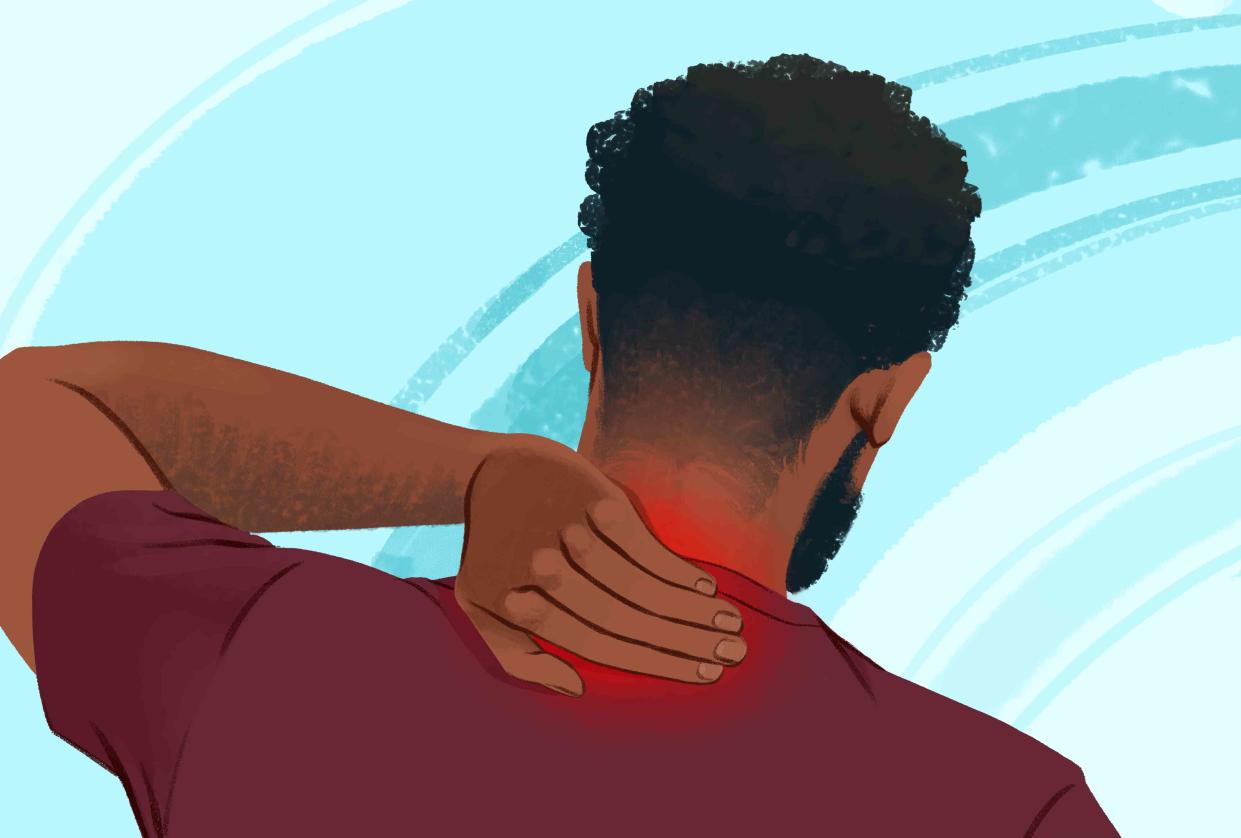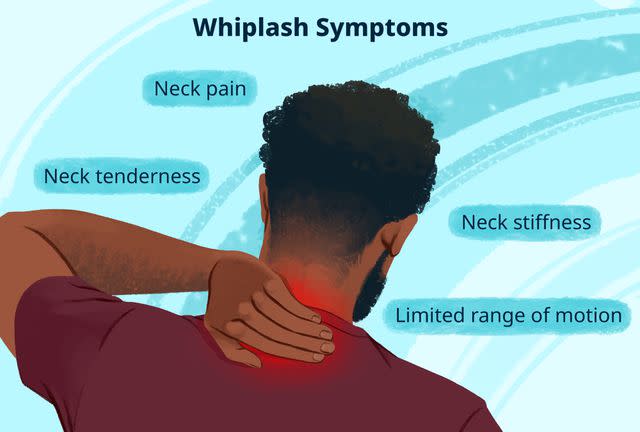Symptoms of Whiplash

Illustration by Mira Norian for Verywell Health
Common symptoms of whiplash include neck pain and stiffness, headache, dizziness, shoulder and back pain, and a tingling sensation in the neck or down the arms. The symptoms and treatment depend on the severity of the injury.
In this article, learn more about the symptoms associated with whiplash and the best treatment options. The article also touches on severe injuries that can lead to complications.

Illustration by Mira Norian for Verywell Health
Frequent Symptoms
Several structures within the neck can be affected by a sudden whipping movement of the head. These structures include muscles, bones, joints, tendons, ligaments, intervertebral discs, blood vessels, and nerves. Any or all of these can be affected by a whiplash injury.
Whiplash, a neck sprain, occurs from sudden neck jerking, often during a motor vehicle collision. Whiplash injuries account for approximately 75% of all survivable road traffic collision injuries.
The most common symptoms that can occur, even with a minor injury, include:
Neck pain
Next stiffness
Neck tenderness
Limited range of motion of the neck
While people can develop some neck pain shortly after an injury, the more intense pain and stiffness associated with whiplash typically do not occur right after the injury. Symptoms are usually the worst the next day (24 hours later). At that time, people seek medical attention and the severity of their injury is determined.
Researchers have found that approximately 65% of people with whiplash develop symptoms within six hours of the injury. 93% of people develop symptoms within 24 hours. 100% of people develop symptoms within 72 hours.
Whiplash vs. Traumatic Cervical Spine Injury
Whiplash typically describes mild to moderate neck injury without significant bony or neurological symptoms. While minor injuries strain the neck muscles, significant neck injuries can lead to fractures and dislocations of the spine and can affect the nerves and spinal cord.
Once a person develops neurological problems associated with a neck injury, the diagnosis changes slightly to traumatic cervical spine injury instead of whiplash. These differences can be confusing since they are on the same spectrum, but whiplash is considered a mild to moderate injury.
A person can better understand the severity of a neck sprain by using the Quebec classification system that divides neck injury into the following five grades:
Grade 0 means there are no neck symptoms or physical exam signs.
Grade 1 means there is neck pain and stiffness but very few findings on physical examination.
Grade 2 indicates neck pain and stiffness, with neck tenderness and decreased mobility or neck range of motion (how far and in what direction you can move your neck), on physical examination.
Grade 3 involves muscle pain and stiffness but also neurologic symptoms such as numbness and tingling, weakness in the arms, or decreased reflexes
Grade 4 involves a fracture or dislocation of the bones of the spinal column
Other Symptoms
Other symptoms that can be associated with whiplash injury but are less common or only occur with a severe injury include:
Migraine headache
Tension headache
Pain in the jaw
Sleep disturbances
Difficulty concentrating
Blurred vision
Dizziness
Reading and driving difficulties
Clinical guidelines for evaluating whiplash injury indicate clinicians should obtain X-rays or computed tomography (CT) scans only if they suspect a high-grade injury (grades 3 or 4).
Rare Symptoms
People with severe injuries can develop rare symptoms that often indicate traumatic cervical spine injury instead of whiplash, and they include:
Tremor
Voice changes
Bleeding in the brain
Torticollis (painful muscle spasms that keep the head turned to one side)
If you develop these symptoms, you probably have more than just whiplash.
Complications
Complications from whiplash can occur, especially with severe grade 3 or grade 4 injuries. However, most people generally recover from their symptoms within a few weeks to a few months. The most common complications of a genuine whiplash injury include chronic (long-term) pain and headaches.
Some research reports indicate that 20% to 40% of people with a whiplash injury are left with chronic headaches.
More significant complications can occur with extreme injuries, but they are associated with cervical spine fractures and dislocations. Sometimes people confuse whiplash and traumatic cervical spine injury, but whiplash is mild to moderate, whereas traumatic cervical spine injury is severe neck damage.
Traumatic cervical spine injury can affect the spinal cord and be associated with chronic neurological problems, including numbness, weakness, and difficulty walking. Some severe injuries lead to paralysis and paraplegia.
Do not confuse these complications with a whiplash injury. Although whiplash is on the spectrum of neck injuries, these more serious complications are associated with traumatic cervical spine injury.
When to See a Healthcare Provider/Go to the Hospital
If you are involved in a fairly significant motor vehicle collision or another type of injury involving the neck, it is important to seek medical attention to assess for severe injuries. This is especially true if you develop any numbness or weakness.
Remember, the pain from a whiplash injury is typically more severe the next day rather than when you visit the hospital shortly after the injury.
Whiplash injury treatment depends on whether it is an acute injury or a person has developed chronic neck pain and stiffness. Acute pain can be treated with over-the-counter (OTC) medicines and moist heat.
Whiplash is like other musculoskeletal injuries, so OTC medications like Tylenol (acetaminophen) and Advil (ibuprofen) effectively treat the pain. Advil is a nonsteroidal anti-inflammatory that can be taken with the pain reliever Tylenol, which work in different ways.
The mainstay of treatment, especially chronic treatment, is encouraging regular activity with stretching and exercise. People can use several range of motion exercises to strengthen their neck muscles and relieve the pain.
People should not restrict neck movement with a hard or soft collar, as they are ineffective for treating acute pain from a whiplash injury.
Muscle relaxers, like Flexeril (cyclobenzaprine), have generally not been shown to improve pain over using the traditional remedies discussed.
Summary
Whiplash is a neck sprain that often occurs after a motor vehicle collision but can happen with any injury that quickly jerks the neck forward and backward. Common symptoms include neck pain and stiffness, and some people can develop chronic pain and headaches.
It is important not to confuse whiplash with traumatic cervical spine injury. Whiplash is a mild to moderate injury of the neck muscles. Treatment includes OTC pain medicines, moist heat, and stretching exercises.

